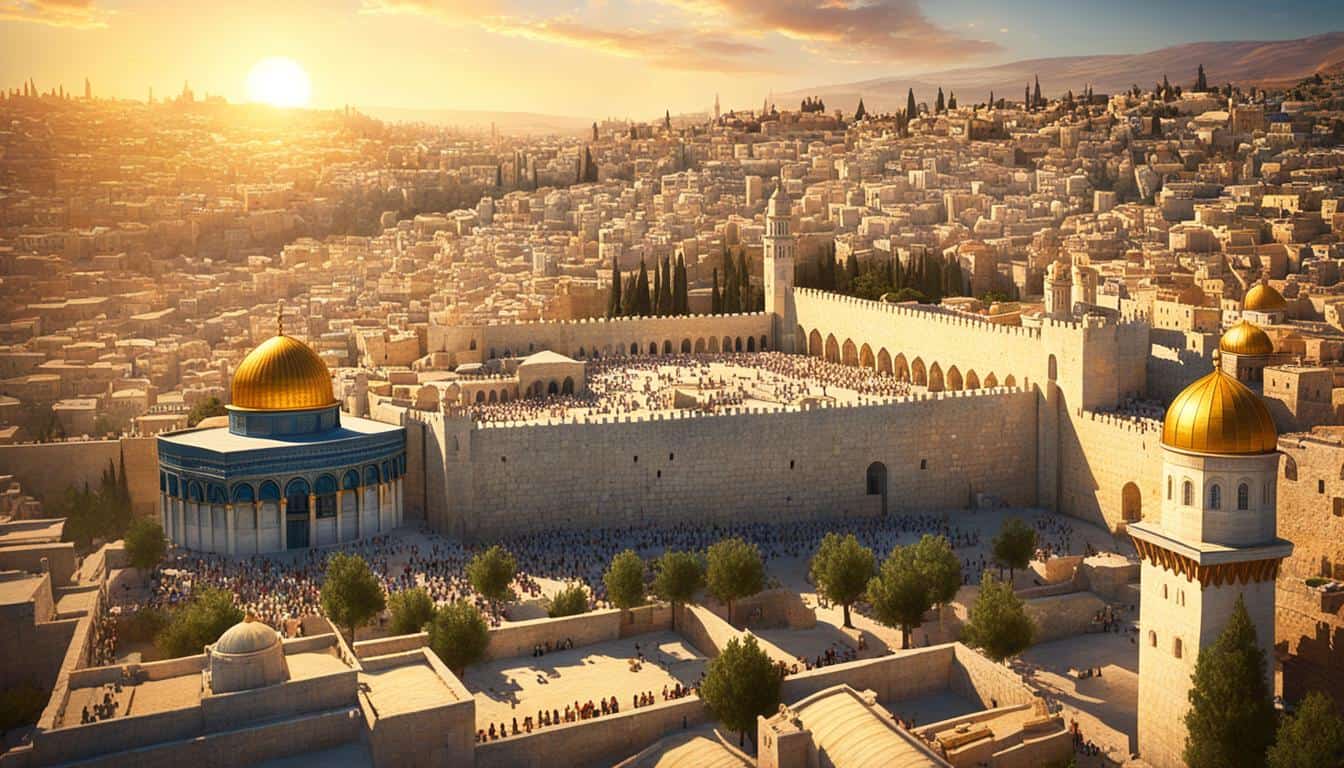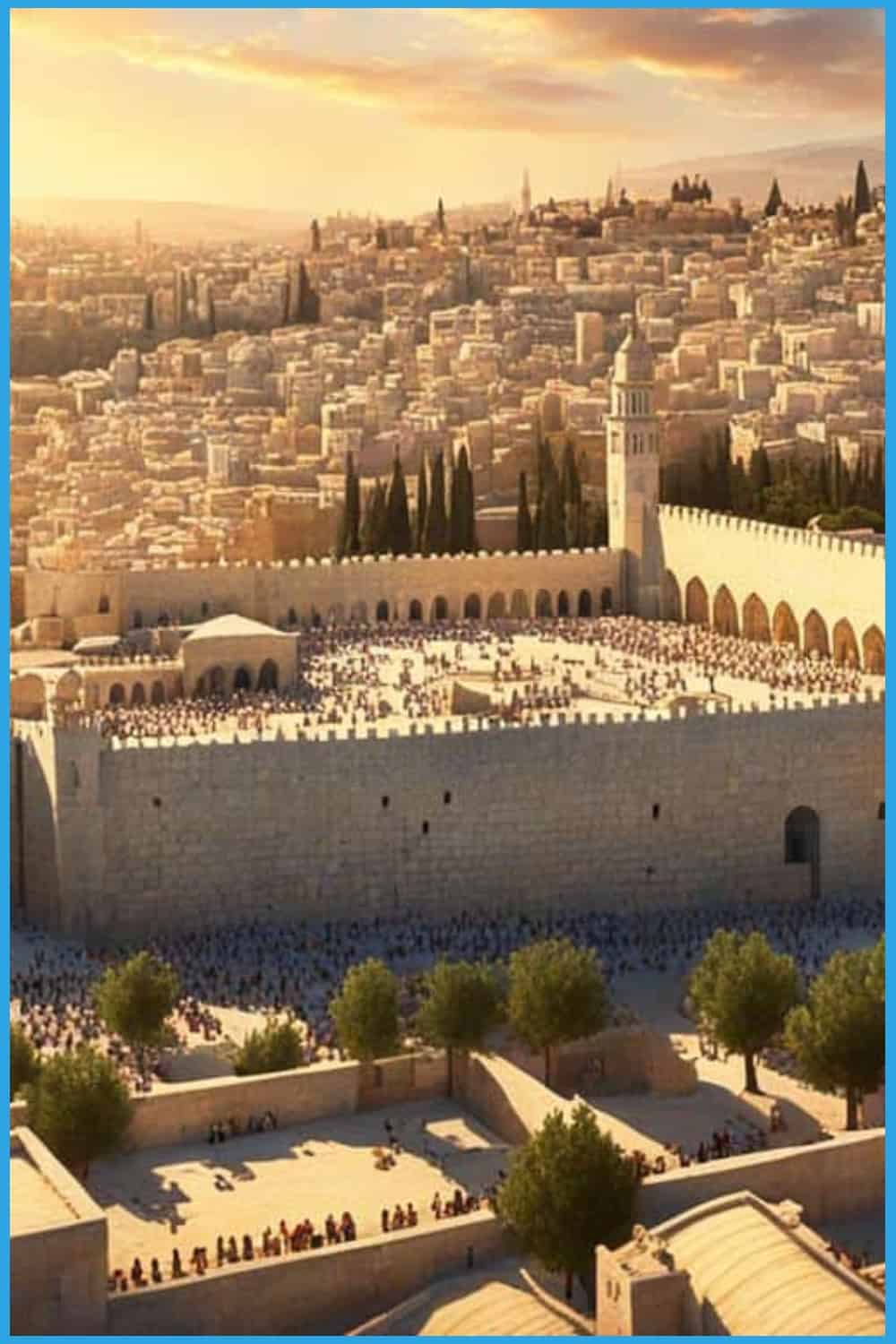Table of Contents
Have you ever wondered about the ancient cities mentioned in the Bible? How did they look? What stories do they hold within their walls? Join us on a journey to uncover the mysteries of the Ancient Cities of the Bible. From Jerusalem, known as the “city of gold,” to Bethlehem, the birthplace of Jesus, each city has a tale to tell.
Step back in time and explore the grand structures that stood tall in these ancient cities. Walk the streets of Jerusalem and imagine the majestic First Temple built by King Solomon, its golden splendor shining in the sunlight. Or visit Bethlehem, a charming town that witnessed the birth of King David and the birth of Jesus, setting the stage for biblical narratives that changed the course of history.
But our adventure doesn’t stop there. We will also discover the dramatic story of Jericho, where the walls crumbled after Joshua blew his trumpet. Explore the thriving metropolis of Nineveh, connected to the tale of Jonah and the big fish. And delve into the fishing village of Bethsaida, where Peter, Andrew, and Philip embarked on their journey as Jesus’ first followers.
Capernaum, often referred to as Jesus’ “home base,” will mesmerize you with stories of miracles performed on the shores of the Sea of Galilee. Ephesus, a bustling metropolis, will transport you to a vibrant world of trade, culture, and the awe-inspiring Temple of Artemis. And don’t forget Babylon, known for its Hanging Gardens, one of the ancient wonders of the world.
Join us as we unlock the secrets of these ancient cities. Each step will immerse you deeper into the captivating stories of faith, history, and human resilience. Are you ready to embark on this extraordinary journey to the Ancient Cities of the Bible? Let’s begin!
Jerusalem – The City of Gold
Jerusalem, often referred to as the “city of gold,” holds a prominent place in the ancient cities of the Bible. This remarkable city witnessed many significant events and played a central role in biblical history. It served as the capital of King David’s kingdom and was the location where Solomon constructed the first temple, a magnificent structure that inspired wonder in those who beheld it.
Jerusalem’s rich history and spiritual significance make it a captivating destination for visitors and a source of inspiration for believers. Let’s explore the captivating stories and remarkable structures that make Jerusalem an integral part of the ancient cities of the Bible.
The Kingdom of David and Solomon
During the reign of King David, Jerusalem became the capital of the united kingdom of Israel. David’s conquest of the city from the Jebusites in the 10th century BCE established Jerusalem as a significant political and religious center.
Under the reign of David’s son, Solomon, Jerusalem reached its peak. Solomon’s Temple, also known as the First Temple, was a marvel of architectural and artistic achievement. Constructed with precious materials, including gold and precious stones, the temple was a symbol of divine presence and the focal point of worship for the Israelites.
This grand golden structure left a lasting legacy in the hearts of those who witnessed its magnificence.
A City of Spiritual Significance
Jerusalem holds immense spiritual significance in several religious traditions, including Judaism, Christianity, and Islam. It is a holy city revered for its sacred sites, including the Western Wall, believed to be a remnant of the Second Temple, and the Church of the Holy Sepulchre, which encompasses the sites of Jesus’ crucifixion, burial, and resurrection.
Throughout history, Jerusalem has been a destination for pilgrimage and a place of worship, drawing believers from around the world seeking spiritual enlightenment and divine connection.
Preserving the Past
Today, Jerusalem stands as a testament to centuries of history, with its ancient ruins, medieval walls, and religious monuments. The Old City, a UNESCO World Heritage Site, encapsulates the essence of Jerusalem’s historical significance.
Exploring the narrow streets, bustling markets, and sacred sites of the Old City offers a glimpse into the diverse cultural and religious tapestry that has shaped Jerusalem throughout the ages.
Whether you visit for historical exploration, spiritual reflection, or cultural immersion, Jerusalem captures the imagination and leaves an indelible mark on all who experience its golden allure.
Bethlehem – The Little Town with Big Stories
Despite its small size, Bethlehem holds great significance in biblical history. Situated in the Judean hills, this ancient town is known as the birthplace of King David and, of course, Jesus. Steeped in history and religious importance, Bethlehem continues to draw pilgrims and visitors from around the world.
Walking through the streets of Bethlehem, you can’t help but feel the weight of the stories that unfolded here. This quaint town evokes a peaceful atmosphere, with its narrow alleys, stone houses, and centuries-old churches. As you explore, you’ll encounter the warm hospitality of the locals, eager to share their deep connection to this sacred place.
One of the most iconic sites in Bethlehem is the Basilica of the Nativity, built over the cave traditionally believed to be the birthplace of Jesus. This UNESCO World Heritage Site is a place of pilgrimage for Christians worldwide, who come to pay homage to the birth of Jesus and marvel at the stunning mosaics and ancient architecture.
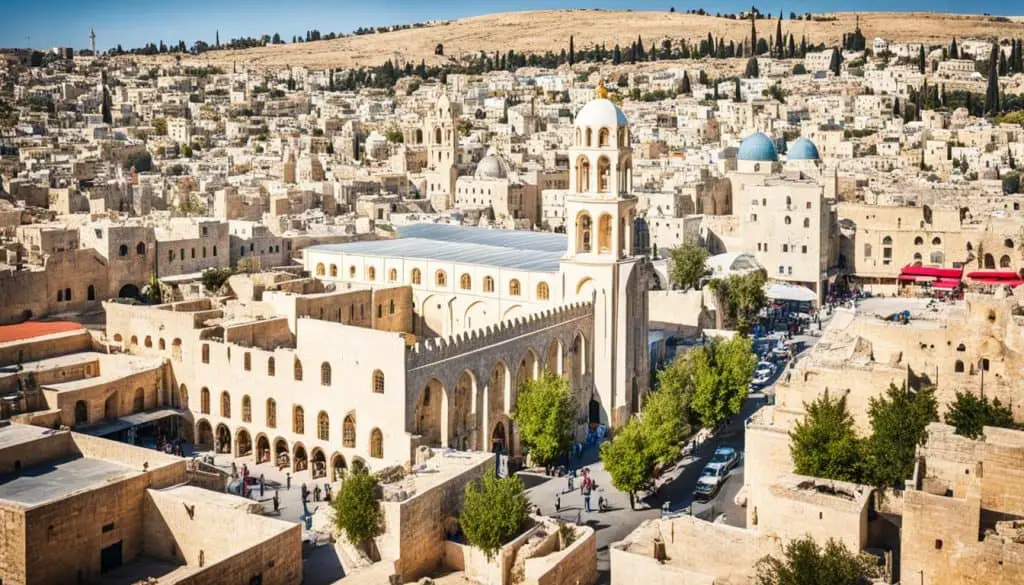
Another significant spot in Bethlehem is the Shepherd’s Field, where shepherds watched over their flocks on the night of Jesus’ birth. It is here that an angel appeared to them, announcing the good news of the Savior’s arrival. Today, you can visit the Shepherd’s Field and stand in awe of the same starlit skies that witnessed this miraculous event.
“But you, Bethlehem Ephrathah, though you are small among the clans of Judah, out of you will come for me one who will be ruler over Israel, whose origins are from of old, from ancient times.” – Micah 5:2
Bethlehem is not just a city frozen in time; it is a vibrant community that thrives amidst its rich history. Local artisans create intricate crafts, including olive wood carvings, which serve as enduring reminders of the town’s cultural heritage. The bustling markets filled with spices, fresh produce, and colorful textiles add to the charm of this ancient city.
Whether you visit Bethlehem for its biblical significance, its unique architecture, or its welcoming atmosphere, this little town with big stories will leave an indelible mark on your heart. As you wander its ancient streets, take a moment to reflect on the profound impact Bethlehem has had on the world and the enduring power of faith.
Jericho – The City with the Tumbling Walls
Jericho, an ancient city mentioned in the Bible, is renowned for its miraculous story of the collapsing walls. According to the biblical account, Joshua and his army marched around the city for seven days, blowing trumpets, and on the seventh day, the walls of Jericho came tumbling down. This awe-inspiring event is often referred to as the Miracle of the Walls.
“By faith the walls of Jericho fell, after the army had marched around them for seven days.” – Hebrews 11:30
Imagine the sheer amazement and wonder of witnessing such a supernatural occurrence. The monumental walls of Jericho, once believed to be impenetrable, crumbled before the eyes of the Israelites, displaying the power of their faith and the intervention of their God.
The city of Jericho, located in the Jordan Valley, holds historical significance not only for its mighty walls but also as an ancient settlement dating back thousands of years. Archaeological excavations have revealed evidence of habitation in Jericho since the prehistoric era, making it one of the oldest continuously inhabited cities in the world.
To give you a glimpse of this fascinating city, take a look at the image below, showcasing the remnants of Jericho’s ancient walls:
| City | Walls Height | Walls Thickness |
|---|---|---|
| Jericho | 4.5 meters | 1.8 to 2.7 meters |
As depicted in the image and table above, the walls of Jericho were approximately 4.5 meters in height, with a thickness ranging from 1.8 to 2.7 meters. Such formidable fortifications testified to the city’s strategic importance and its role in the biblical narrative.
The story of Jericho and the Miracle of the Walls showcases the faith, courage, and divine intervention that are often depicted in the Bible. It serves as a testament to the power of belief and the remarkable events that unfolded in the ancient cities of the Bible.
Nineveh – The Big City with a Big Fish Story
Located in the heart of the ancient Assyrian Empire, Nineveh was a bustling metropolis that left a lasting mark in history. Its remarkable connection to the biblical story of Jonah and the big fish adds a fascinating layer to its legacy.
According to the Book of Jonah, the reluctant prophet Jonah received a divine message instructing him to go to the city of Nineveh and warn its inhabitants of their impending destruction. However, Jonah initially tried to evade his duty and boarded a ship bound for Tarshish. As the story goes, a great storm arose, and the crew, fearing for their lives, threw Jonah overboard.
The Story of Jonah and the Big Fish
“But the Lord provided a great fish to swallow Jonah, and Jonah was inside the fish three days and three nights.” – Jonah 1:17
Jonah found himself in the belly of a massive fish, where he spent three days and nights in prayer and reflection. Realizing the error of his ways, Jonah finally accepted his mission and was eventually vomited out by the fish onto dry land.
Jonah then made his way to Nineveh, delivering a message of repentance to its inhabitants. To his surprise, the Ninevites heeded his warning and turned away from their wickedness, seeking forgiveness. The city was spared from destruction, and Jonah witnessed the power of God’s mercy and compassion.
This gripping tale of Jonah and the big fish has captivated readers for centuries, highlighting the significance of Nineveh in biblical narratives. It serves as a reminder of the power of redemption and the unfathomable ways in which divine providence can work.
The Splendor of Nineveh
As the capital of the mighty Assyrian Empire, Nineveh was renowned for its grandeur and architectural achievements. Its impressive fortifications, majestic palaces, and bustling markets reflected the wealth and power of the empire.
To gain a visual understanding of the magnificence of Nineveh, take a look at this artist’s depiction:
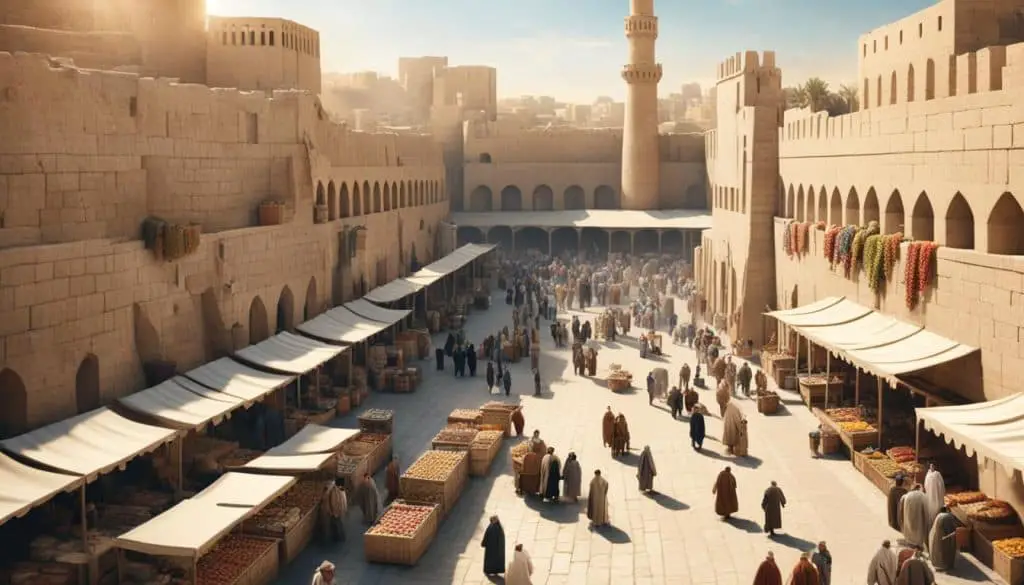
Key Facts about Nineveh
| Location | Date | Significance |
|---|---|---|
| Northern Mesopotamia (Modern-day Iraq) | Approximately 705-612 BC | Capital of the Assyrian Empire |
| Population | Estimated at over 100,000 | One of the largest and most populous cities of its time |
| Archaeological Discoveries | Palace of King Sennacherib, City Walls, Royal Library | Revealing insights into the Assyrian civilization and culture |
Excavations in the modern-day city of Mosul, Iraq, have unearthed impressive remains and artifacts that offer a glimpse into the grandeur of Nineveh. The discoveries provide valuable insights into the ancient world and confirm the historical accuracy of biblical accounts.
In summary, Nineveh’s prominent role in biblical narratives, particularly the story of Jonah and the big fish, makes it a city of great intrigue and significance. Its importance as the capital of the Assyrian Empire further solidifies its place in history as a thriving metropolis of immense power.
Bethsaida – The Fishermen’s Hub
Bethsaida, an ancient fishing village located on the shores of the Sea of Galilee, played a significant role in biblical history. It was the hometown of several prominent figures in the New Testament, including Peter, Andrew, and Philip, who would later become Jesus’ disciples and play key roles in spreading his teachings.
The village of Bethsaida was known for its vibrant fishing industry, with fishermen setting sail on their boats to cast their nets and seek a bountiful catch in the abundant waters of the Sea of Galilee. The livelihood of many inhabitants depended on the success of their fishing expeditions, making Bethsaida a bustling hub of activity.
“Follow me, and I will make you fishers of men.” – Jesus (Matthew 4:19)
These words spoken by Jesus to Peter and Andrew highlight the strong connection between the fishing trade and the spiritual journey of these disciples. In Bethsaida, the fishermen’s lives were transformed as they left behind their nets to become messengers of love, hope, and faith.

Exploring Bethsaida allows us to imagine the bustling scene of fishermen preparing their boats, mending their nets, and eagerly setting sail at dawn. It provides insight into the daily lives and challenges faced by the early followers of Jesus, as they balanced their fishing responsibilities with their newfound commitment to spreading the teachings of Christ.
The Significance of Bethsaida
Bethsaida’s significance extends beyond its association with Peter, Andrew, and Philip. The village witnessed many important biblical events, including the feeding of the five thousand, where Jesus performed a miracle and multiplied a few loaves of bread and fish to feed a multitude of people.
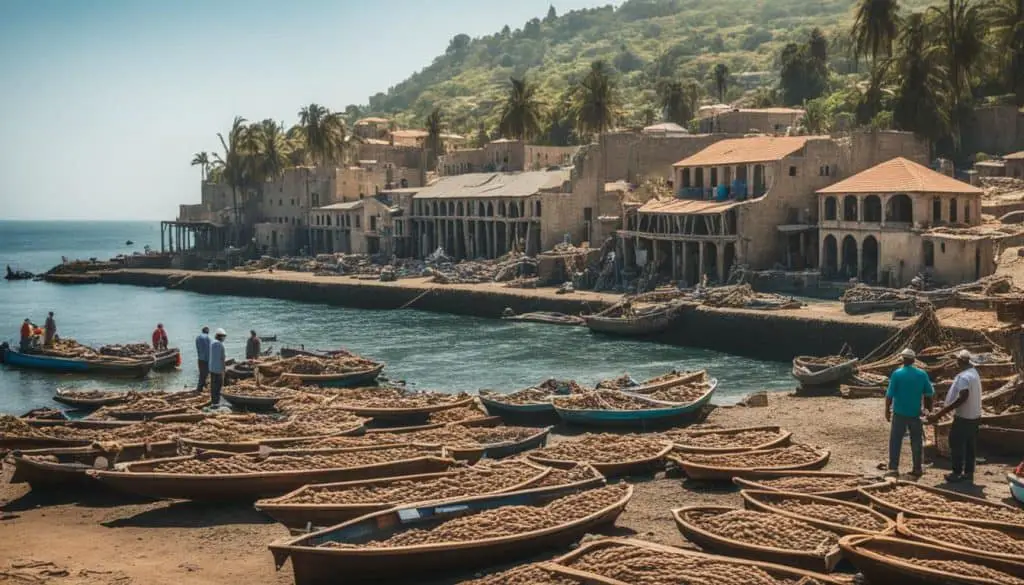
Furthermore, Bethsaida serves as a backdrop for some of Jesus’ teachings and miracles. It was in this humble fishing village that Jesus healed a blind man by applying saliva to his eyes and restored his sight. Such acts of compassion and healing accentuate the transformative power of Jesus’ ministry.
The Timeless Lessons of Bethsaida
Bethsaida stands as a reminder of the profound impact that ordinary individuals, like fishermen, can have on the world. It emphasizes the transformative power of faith and the remarkable journey of personal growth experienced by Peter, Andrew, and Philip.
The stories of Bethsaida inspire us to recognize the potential for greatness that lies within each of us, regardless of our background or occupation. Just as these fishermen left their nets to follow Jesus, we too can embark on our own journeys of self-discovery, growth, and service to others.
In Bethsaida, the simplicity of a fishing village intertwines with the extraordinary events of biblical history, reminding us that amidst the ordinary, the extraordinary often unfolds.
Capernaum – Jesus’ Home Base
Capernaum holds a significant place among the ancient cities mentioned in the Bible. Situated by the picturesque Sea of Galilee, this city served as the central location for Jesus’ ministry. It was here that he performed numerous awe-inspiring miracles, leaving a profound impact on the lives of those who witnessed them.
One of Jesus’ notable miracles in Capernaum was the healing of a paralyzed man. This astonishing act of compassion and power showcased his divine authority and brought hope to the lives of the afflicted.
Walking through the ancient streets of Capernaum today, one can still sense the spiritual energy that once filled this place. Imagining the bustling crowds seeking Jesus’ teachings and the miraculous healings that took place is a truly humbling experience.
“And when he returned to Capernaum after some days, it was reported that he was at home. And many were gathered together, so that there was no more room, not even at the door. And he was preaching the word to them. And they came, bringing to him a paralytic carried by four men. And when they could not get near him because of the crowd, they removed the roof above him, and when they had made an opening, they let down the bed on which the paralytic lay. And when Jesus saw their faith, he said to the paralytic, ‘Son, your sins are forgiven.'”
Sea of Galilee – A Place of Miracles
The Sea of Galilee, also known as Lake Kinneret, surrounded by the ancient city of Capernaum, served as a backdrop for many of Jesus’ miracles. Its tranquil waters witnessed the extraordinary moments when waves were stilled and fishermen became disciples.
In Capernaum, Jesus recruited several of his first disciples, including Simon Peter, Andrew, James, and John. These fishermen left their nets behind to follow him, becoming witnesses to the incredible miracles and teachings that unfolded by the shores of the Sea of Galilee.
The Sea of Galilee continues to captivate visitors with its stunning beauty and historical significance. Standing on its shores, one can reflect on the transformative events that unfolded in Capernaum and the timeless lessons still relevant today.

Ephesus – The Ancient Metropolis
Ephesus, located in present-day Turkey, was a bustling metropolis of the ancient world and a prominent city mentioned in the Bible. With its rich history and remarkable architecture, Ephesus holds a special place among the Ancient Cities of the Bible.
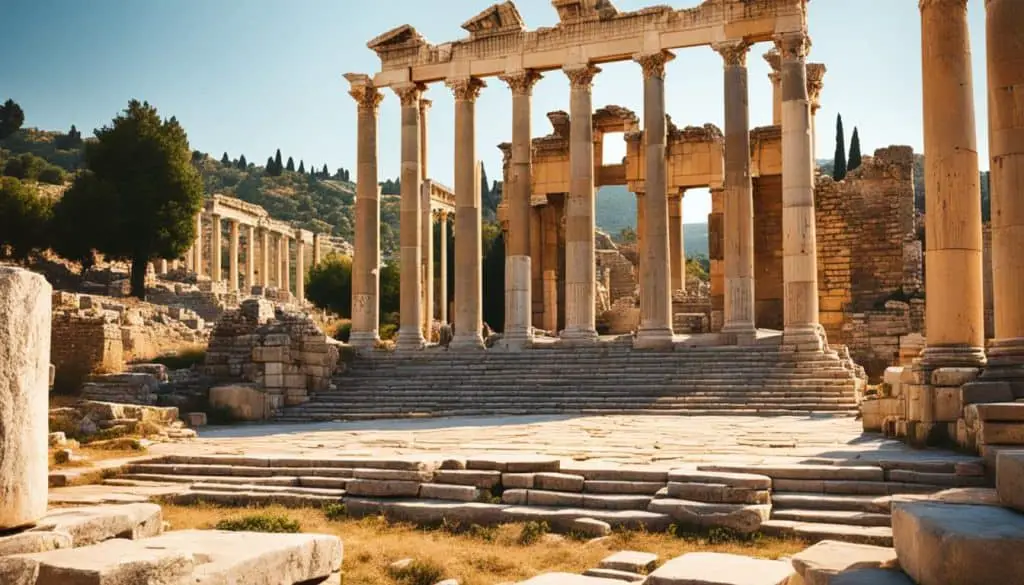
The centerpiece of Ephesus was the awe-inspiring Temple of Artemis, one of the seven wonders of the ancient world. This magnificent temple stood as a symbol of grandeur and devotion, attracting worshippers and visitors from far and wide.
“Ephesus is the greatest metropolis in Asia,” mentioned in the Bible (Acts 19:28)
The city of Ephesus bustled with life. Traders from across the ancient world converged in its bustling marketplace, while scholars gathered to exchange knowledge and ideas in its renowned Library of Celsus.
Ephesus was also a significant Christian hub. The Apostle Paul spent several years in Ephesus, preaching and establishing early Christian communities. His letters to the Ephesians, found in the New Testament, offer insights into the challenges and faith of the emerging Christian community in this vibrant city.
The Ruins of Ephesus
Today, visitors can explore the remarkable ruins of Ephesus and uncover its rich history. The iconic Celsus Library, the grand theater, and the Marble Road are just a few of the well-preserved remnants that transport you back in time.
Don’t miss:
- The Ancient Theater: This immense structure could seat up to 25,000 spectators and hosted theatrical performances and gladiatorial contests.
- The Terrace Houses: Step inside the homes of the wealthy, adorned with intricate mosaics and frescoes, and marvel at the luxurious lifestyle of the Ephesian elite.
- The Temple of Artemis: Although only a few pillars remain, it’s still possible to imagine the grandeur and significance of this ancient wonder.
| Exploring Ephesus | Highlight |
|---|---|
| The Celsus Library | A stunning architectural marvel that housed thousands of scrolls and served as a symbol of knowledge and learning. |
| The Ancient Theater | An impressive amphitheater that once resonated with the sounds of entertainment and political speeches. |
| The Terrace Houses | A glimpse into the opulent lifestyles of Ephesus’s wealthy residents, with intricate mosaics and frescoes. |
Visiting Ephesus offers a remarkable opportunity to explore the ancient past and to appreciate the vibrant culture and history of this ancient metropolis.
Babylon – The City of Hanging Gardens
Despite not being mentioned positively in the Bible, Babylon’s grandeur cannot be denied. It is famous for its Hanging Gardens, which were considered one of the seven wonders of the ancient world. Picture a stunning city oasis with lush, floating gardens amidst the desert landscape.
When one thinks of Babylon, the Hanging Gardens immediately come to mind. Built by King Nebuchadnezzar II in the 6th century BCE, these extraordinary gardens were a marvel of engineering and horticulture. They were designed to please the senses, with vibrant flora and cascading water, creating a breathtaking spectacle that defied gravity.
The Hanging Gardens served as an oasis in the heart of the bustling city of Babylon. They were a testament to the prosperity and ingenuity of the Babylonian civilization. The gardens were built on raised platforms, allowing the terraced levels to cascade with foliage, creating a lush, green sanctuary amidst the arid surroundings.
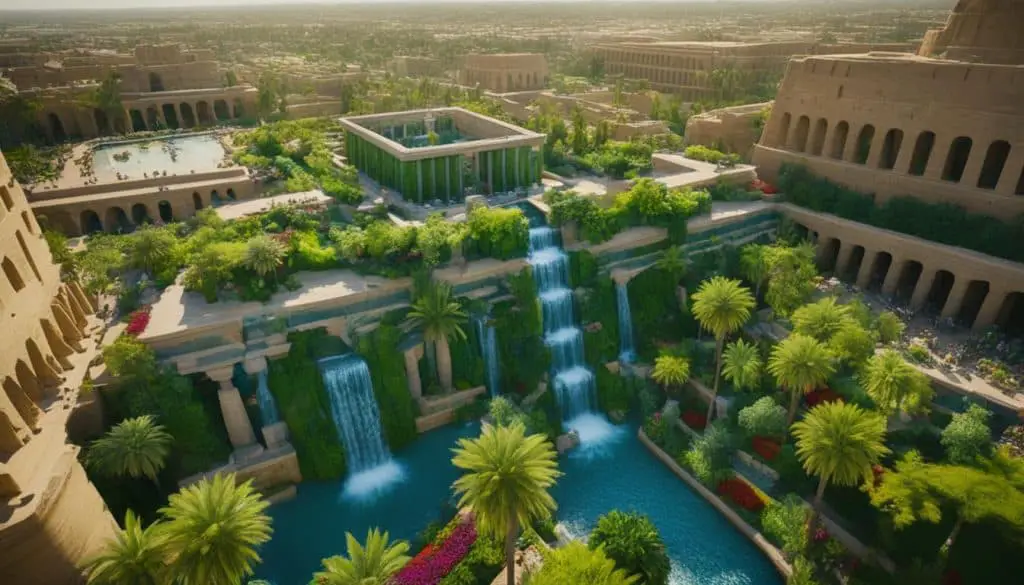
The gardens were adorned with a variety of plants and trees, showcasing the diversity of Babylonian flora. Fragrant flowers, exotic shrubs, and towering trees created a paradise-like atmosphere, captivating the imagination of all who beheld them.
The Hanging Gardens of Babylon have inspired countless stories and legends throughout the ages. Although their exact location remains a mystery, their beauty and grandeur continue to captivate the world. They serve as a testament to the architectural and horticultural achievements of the ancient world.
What is the historical significance of the structures in the ancient cities mentioned in the Bible?
The historical houses in New Testament cities like Jerusalem, Bethlehem, and Jericho hold immense significance in biblical history. These structures are mentioned in various texts, serving as vital settings for pivotal moments in religious stories. They offer a glimpse into the rich history and cultural significance of these ancient cities.
Exploring the Ancient Cities of the Bible
As we conclude our journey through the ancient cities of the Bible, we are left in awe of the historical significance and profound impact these places have had on biblical stories. These cities were not mere settings for the narratives; they played active roles, shaping the lives of the people involved and leaving a lasting legacy for generations to come.
By exploring the stories and structures of these ancient cities, we gain a deeper understanding of the biblical narratives. We witness the grandeur of Jerusalem, the birthplace of King David and the site of the first temple built by Solomon. We marvel at the miracle of Jericho’s walls tumbling down, a testament to the power of faith and divine intervention.
We witness the bustling fishing villages of Bethsaida and Capernaum, where Jesus performed miracles and called his first disciples. We step into the metropolis of Ephesus, adorned with the marvelous Temple of Artemis, and experience the opulence of Babylon’s Hanging Gardens, one of the seven wonders of the ancient world.
These ancient cities of the Bible hold immense historical significance. They bring to life the stories of kings, prophets, and ordinary people who lived in their shadows. They remind us that beyond the words on the pages, the Bible represents a profound connection to our shared human history and the enduring power of faith.

